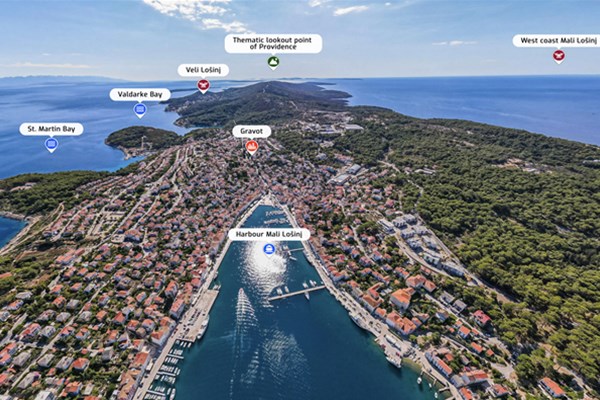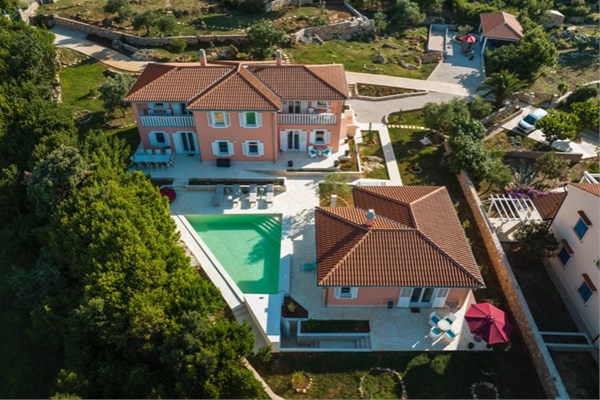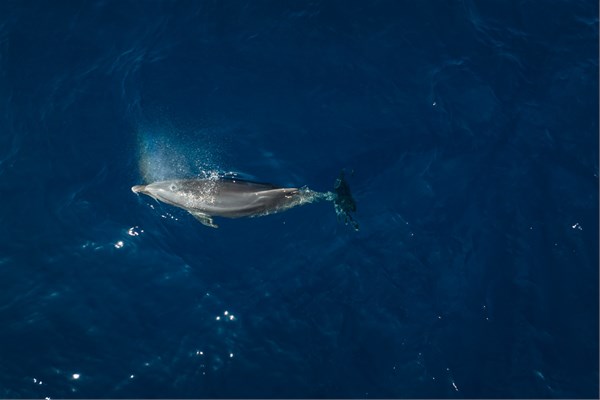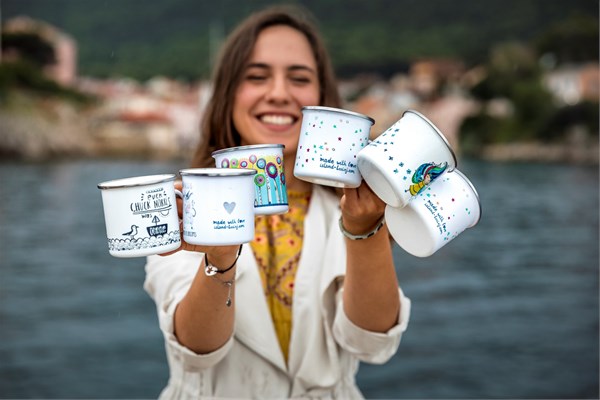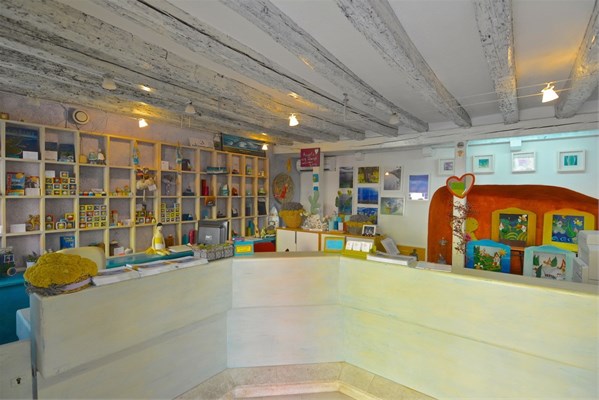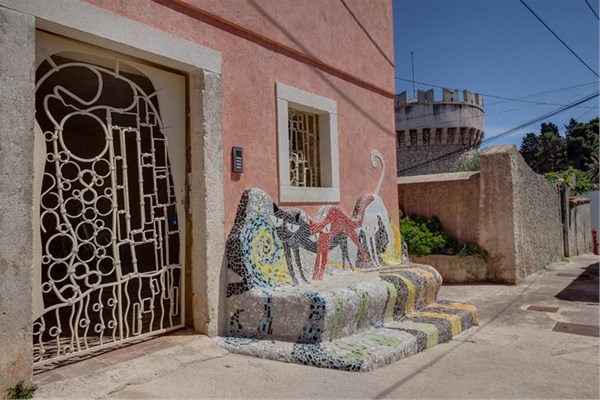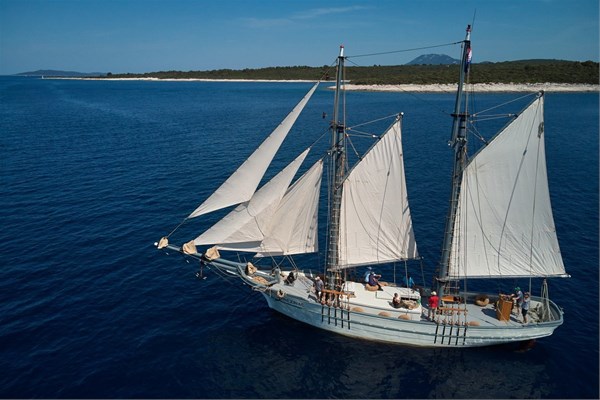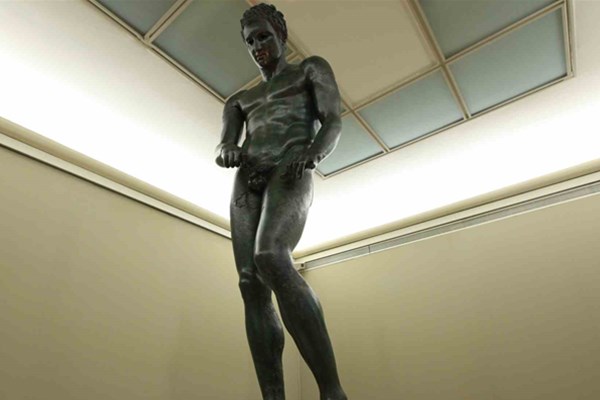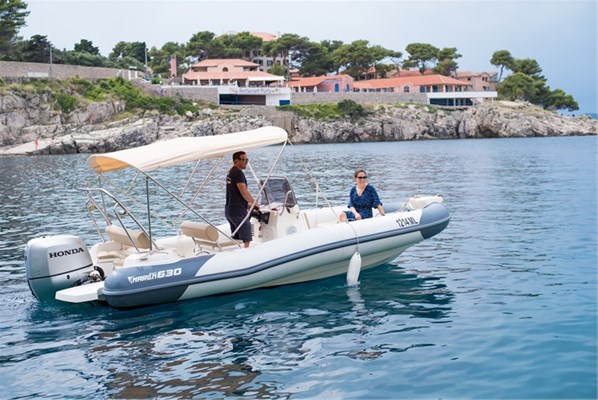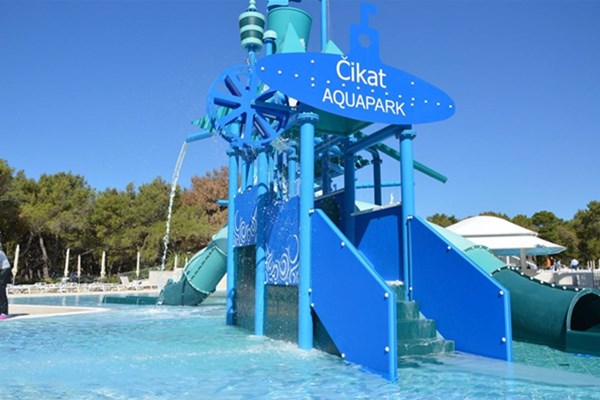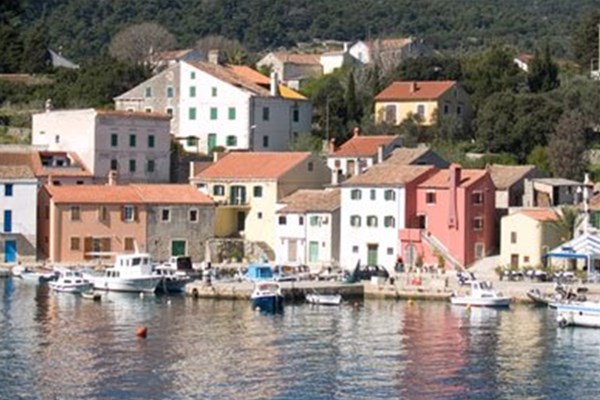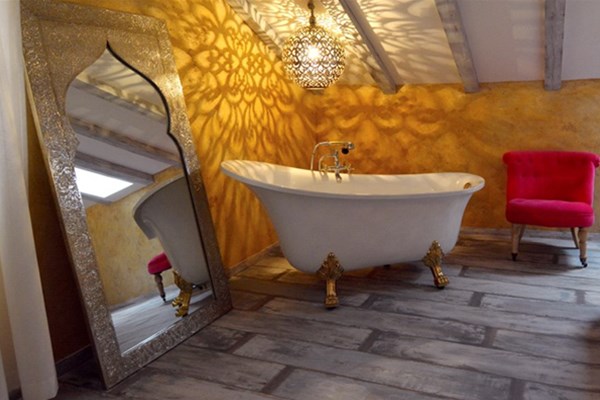Culture and history
Genesis of the islands
Research has shown that Lošinj island has been inhabited since Neolithic and maybe the end of Paleatolitic period. Many cultures lived in this area, from the old Illyrians and Liburnians, Greeks, Romans, until Austrians and Italians, and finally Croatian as it is today. Each generation left a path in today's culture. The most people like to hear legend about genesis of the islands.

The well known legend is the one about tragic death for love - the myth of Apsyrt - from where the common ancient name for the islands - Apsyrtides. He was searching for Father's the Golden Fleece, stolen by Jason - member of Argonauts. Apsyrt father was king of Kohlita kingdom. Apsyrt had sister Medea. She was fallen in love with Jason. Medea and Jason When Apsyrt finally finished his reach the Golden Fleece, Medea managed to entice her brother Apsyrt into negotiations where Jason killed him from ambush. Medea had cut apart Apsyrt's dead body and thrown his limbs into the sea. From Apsirt's body came into being the island of Apsirt - the Apsyrtides.
Ancient Tower

In the middle of the 15th century, the Venetian rulers built a free-standing round defensive tower decorated with masks on stone consoles for the protection of Veli Lošinj. This is a typical Renaissance round tower, with thick walls and a relatively shortheight to withstand cannon fire. The upper parts of the walls leant outward, which made it easier to aim at attackers. The parapet of the tower has experienced the greatest amount of changes through time, and has not been preserved in its original form.
The inhabitants of Lošinj organized the maritime defense of the settlement on their own initiative to protect their property from Turkish and Uskok raids, and from other enemies of Venice in the 15th-17th centuries. When the turbulent times passed, the Tower was left without a garrison and was abandoned to decay. In 1774, it was renovated, but the Venetian Republic was soon to disappear from the historical scene in the Napoleonic Wars, and the new ruler of the Kvarner islands was Austria, which had no need for the Veli Lošinj fortification. Only in 1911 did the Central Commission in Vienna, perhaps acting on the recommendation of the Archduke Charles Stephen, order the walls restored, but not the roof and the wooden structures of each floor, so that the tower continued to deteriorate.
The Rijeka office of the State Administration for the Protection of the Cultural and Natural Heritage began the project of renovating the Tower in 1992 by drawing up plans and collecting documentation, and the actual restoration began in 1997, with funding from the City Mali Lošinj and the Italian Veneto province. The walls were repaired, a new wooden roof was reconstructed, and the wooden structures between the floors were restored. The foundation level was established through archaeological excavations in front of the Tower in 1991, and excavations in the interior in 1997 showed that the tower was constructed directly onto the bedrock. With the installation/establishment of the museum-gallery exhibition area, which guarantees constant care for this important structure of the local architectural heritage, the Tower was opened to the public in the year 2000.
Church St. Anthony

An impressive baroque parish church with a tall bell tower rising at the very seaside. The first church, St. Anthony the Hermit, was built in the 15th centruy. In the 17th centruy it was replaced int the same spot by a larger church. Today's church, still at this same location, was built in the 18th centruy, or to be more precise, in 1774. Thanks to the captains of Veli Lošinj, today this church possesses the larges collection of artistic painting on the Kvarner. In earlier times, church altars used to be made of wood and were ofthen changed. This custom continued even after the altars were raplaced by marble ones. Thus, when some larger church was renewed, it s altars could be boucht. Thanks to this the captains of Veli Lošinj ornamented their parich church magnificently with seven baroque altars. This was also the case with paintings and other works of art. In the golden age of navigation on the islands, the captains literally competed in bringing home valuable works of art, which, luckily, many ended up in churches and, in this way, remained accessible to a large number of people.
Legend of St. Gaudentius

An historic story tells us that Gaudencij - benedictinian, who was pronounced bishop and later confronted the sinful life of the citizens of Osor with his words and acts. He was then expelled from town and lived on the mountain peaks as a hermit. According to the legend he cursed all poisonous snakes on the island and that is why, according to the belief, that there are no such snakes on Cres and Losinj. The climbing path leads to the Televrin peek (588m).
Exists the legend why on the islands Cres and Lošinj aren't poison snakes...
St. Gaudentius (Gaudentius Auxerensis) was born in Tržić in the vicinity of Osor. He establishes the Osor Abbey. As a great cultural reviver he initiated the construction of St. Peter's monastery for men and the St. Mary of Mercy monastery for women. Osor became a strong glagolitic centre. This did not comply with the wishes of some noble men from Osor, and they attacked him. The bishop Gaudent escaped from the town, and was hiding on the hill Osorščica. He lived in a cave for one year. The cave was full of snakes and while he was repenting, he begged God for mercy to free these islands forever from poisonous snakes. He escaped to Rome where he died.
After almost one hundred years his mortal remains returned in a miraculous way: all the bells began to ring by themselves early before dawn. Under the town wall there was a wooden chest in the sea. Its remains are kept safe in the religious collection. In it there was another iron chest with the body of St. Gaudentius. Inhabitants of Osor erected a small church to his memory. He was proclaimed the patron saint of the town and the whole island.
Susak's costume

Susak's costume is very interesting and different from all other in this area. Usually costumes have long skirts, but Susak's costume is specific because the mini skirts. It consist several layers which designs originate from various time periods a cultural environments. They are made for specific life age and occasions. The everyday do the national costume canstill be seen today.
There are two species of costumes, one named "po susacku" (in way of Susak) is for every day's use; other named "po losinjsku" (in a way of Losinj) is for festive occasions.
The shoes - for festive accasions, called "socks" are made of felt and are tiesd with a red woolen string named "valnica". Working shoes are handmade, called "pute". The shoes are made of fabric, while the sole is of lamb skin or fabric. Stockings ("kalcete") are made of wool, and are of a bright red color.
The bloomers ("mudonde") - can't be seen, are of cotton with lace ("merlici") along the edges. Shirt is of cotton, white colored with lace around the collar and sleeves. Underskirt ("suknica") is white, made of cotton cloth, and ornamented with varicolored flowers and the like.
The vest ("bust") is very tight, of intense color with floral designs and decorated with tinsel. It is fastend with three buttons.
The skirts ("kamizoti") are consisted of 5 to 6 white skirts. The first skirt skirt (the bottom one) is the shortest, and the others are, each several centimeters longer than the previous one. This renders the conical shape to the costume. The edge is of white handmade lace ("kamufi"). Top skirt ("pleated kamizot") is usually white or with thin longitudinal red or blue stripes. Fabric is usually hand puckered silk or similar. Folds or waves of the fabric are produced by binding the skirts tightly with a rope and letting them wrinkle in that way. Procedure is repeated several times,
The apron ("traviersala") is intensely ornamented with flashly colored ribbons, bands and pearls. Scarf ("bravaruol") is worn around the neck, of bright colors and rainbow tassels, and at the front it is fastened around the waists. Hair style resembles a crown-like arrangement, and is decorated with varicolored ribbons. Since the costume is of flashy colors as it is, other adornments are not customary.
Man's costume, less attractive than woman's, is not much different from other civilian dress of the 19th century. Already mentioned fabric shoes are called "pute". Trousers are black or navy blue. Shirt is colorated. Around the waist is a wide band of oriental designs (supposedly purchased in Istanbul). Ties were also worn in the past. Vest is usually black or dark colored, head was always covered with cap or sailor's beret.
Unique bronze statue Apoksiomen

The origin of the name Apoxyomenus can be traced in the ancient times. It is masterpiece of Lisipus, famous sculptor.
The bronze statue Apoxyomenos was found in 1996, by the islet Vele Orjule, near the island of Lošinj. After years of conservation it was presented to the public.
Let's start from the beginning... It was found by a Belgian tourist. The statue was lying at depth of approximately 45 meters, stuck between two rocks covered with sand. After studying how, the bronze ancient statue was brought to the surface in spring of 1999, and forwarded to Archeological Museum in Zadar, as well as special police and professional divers.
After the raising, team of experts examined the statue, and gamma graphic imaging was carried out to provide a better picture of the statue. The front of the statue was completely covered by thick layer of incrustation which helped to keep up the original patina from effects of marine processes. The lead join of head and neck had completely given away, it come apart from the body; cracks on the left shoulder and the front and rear of the upper right leg were observed. The little finger was missing from the left hand and the inserts that should have been in the eye sockets were not found.

The Croatian conservation institute had been involved in the project, by having built a structure used during the raising, the transportation and desalinization, and during the systematic conservation and restoration works until the statue was presented. The project was observed and coordinated by specialists and experts. No chemical substances were used in the removal of the incrustation.
The statue would not be able to stand were it not for the special internal support that has been installed. It bears the entire weight of the statue, transmitting it from the foot, loaded in the contraposition, to some twenty places in the head, shoulders, arms, torso, hips and ending in the anti-seismic base. The statue consists of seven separately cast parts (legs, arms, torso, head and genitals) and the base. It was made with the indirect lost wax method, traces of the casting and joining processes being particularly easy to see inside the body. Samples of materials were dated to between 1st century BC and 2nd century AD.
Thanks to these consecration and restoration works the real beauty of the statue come out on the surface. The copy of it is exhibited in museum gallery in the tower in Veli Lošinj.
The original statue is now permanently situated end exhibited in new museum in Mali Lošinj, opened 30.4.2016.
Vransko lake

A natural phenomenon, its level is above sea level which surrounds the lake, and its bottom is 74 m below the sea bottom. It is 5.5 km long, 1.5 km wide and its surface area is 5.75 square kilometers. This freshwater lake is a natural reservoir of healthy water for drinking, as well as home to a lot of freshwater fish.
One of the legends says... Once upon the time there lived two sisters. One was rich and wicked and did not want to help her poor and good sister. The year was very dry, and poor sister asked the rich one for water and food, but she didn't want ho help. As always, the rich sister was caught up by a deserved punishment. The water in the lake rose and flooded the wicked sister's castle, which is still stands at the bottom of the lake. During gales strange sounds and tolling of bells come out from the depths of the lake.
NEREZINAC LUGGER – SAILING INTERPRETATION CENTRE
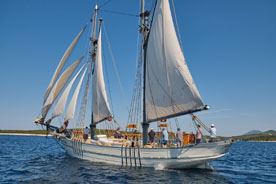
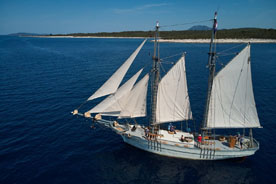
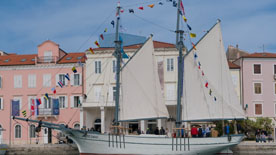
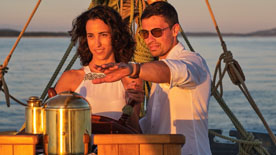

Visit sailing Interpretation Centre of Lošinj's Maritime Heritage NEREZINAC LUGGER FROM LOŠINJ – Open-air Museum !
The sailboat was restored to resemble the local lugger ships from the late 19th century. It is moored at the Riva Lošinjskih kapetana in front of the Museum of Apoxyomenos, and in a modern, interesting, and interactive manner it presents and interprets the long and rich maritime history of the island of Lošinj.
The wooden motorboat Dražica, which was renamed to Nerezinac after refurbishment, is a valuable example of traditional shipbuilding. It was added to the register of protected cultural goods of the Republic of Croatia in 2010.
The display covers three areas: the waterfront in front of the ship, the ship's main deck, and the steerage (former cargo hold).
Multimedia display in steerage – presents life aboard a ship through five thematic units: crew, food, cargo, maritime routes, and construction and ship maintenance.
Presented with the basic facts about the ship, the visitors are invited to imagine possible stories and scenarios because, apart from the general information of this type of ship, the period when it was built and when it sailed, and the type of cargo it carried, there is very little concrete information about it. The history of the Nerezinac lugger is almost completely unknown.
The display on the waterfront and the main deck presents an educational board with ship's data and a workshop area where the visitors can see some of the traditional shipbuilding skills, ship maintenance, or experience sailing and steering skills on the main deck: caulking, sail repair, how to plane wood, filing, driving treenails, steam bending planks, tying boating knots, cleaning the main deck, blowing the horn, lifting the visitors with pulley, raising the sails, and other.
The ship also participates in tourist events that include regattas of traditional boats.
This navigational interpretation centre is moored in front of the Museum of Apoxyomenos in Mali Lošinj!
It is possible to visit from Monday to Saturday in time: 9 AM - 1 PM / 5 PM - 8 PM (Sunday closed).
The entrance is free!
